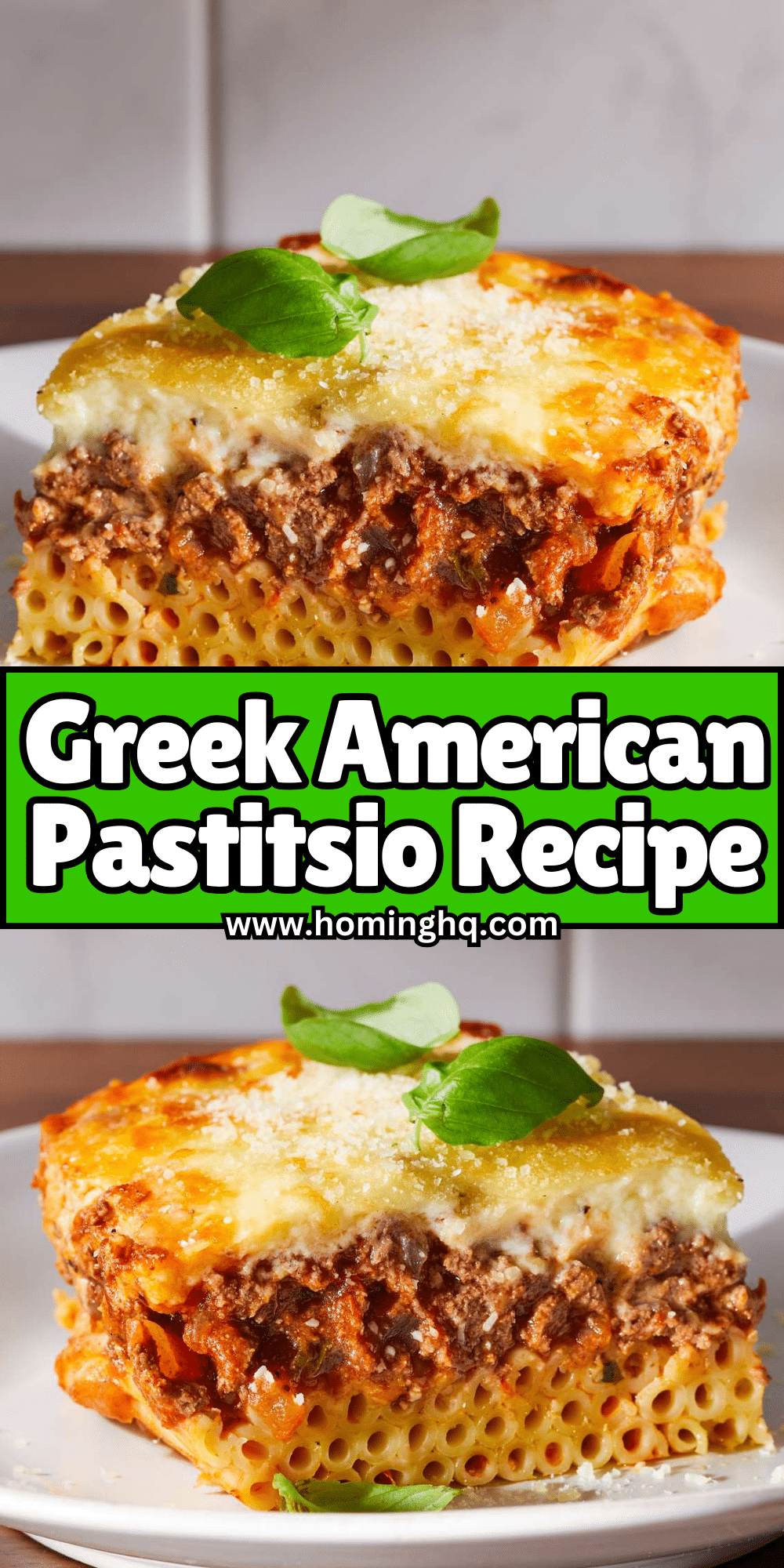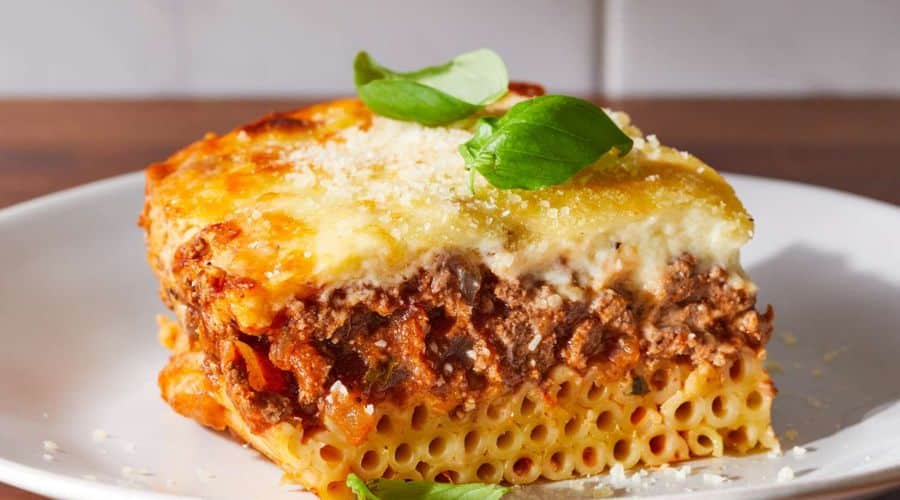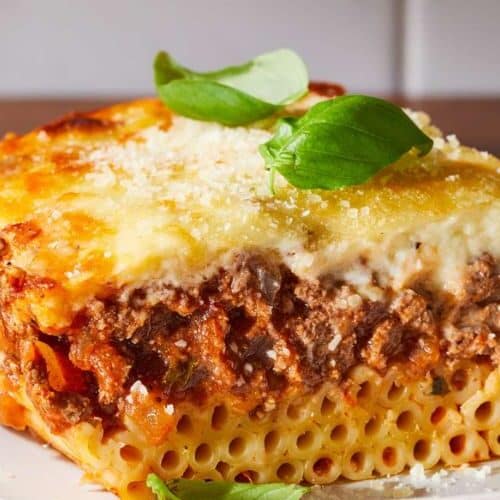All products are selected by our editorial team for quality. If you buy through our links, we may earn a small commission at no extra cost to you.
Greek-American Pastitsio is a dish that beautifully blends traditional Greek flavors with comforting American influences.
It is often described as a Greek lasagna, but its distinct layers and aromatic spices give it a unique personality.
The dish consists of pasta, a flavorful meat sauce, and a rich béchamel sauce, creating an irresistible, hearty meal.
Pastitsio is not just a meal; it’s a celebration of family gatherings and cultural fusion, making it the perfect choice for any special occasion.
Whether you’re familiar with Greek cuisine or new to it, this comforting dish will undoubtedly win over your taste buds and become a staple in your recipe collection.

What is Greek-American Pastitsio?
Greek-American Pastitsio is a variation of the traditional Greek Pastitsio, which itself is a layered pasta casserole filled with ground meat and topped with a creamy béchamel sauce.
The key difference between the two versions lies in the way they are prepared and the flavors they embody.
In the Greek version, Pastitsio often features a more authentic Mediterranean touch with lamb and simpler seasoning.
However, the Americanized version leans towards ground beef, making it more accessible for a variety of tastes.
While both versions feature the same fundamental layers—pasta, a seasoned meat sauce, and béchamel—Greek-American Pastitsio is a hearty, comforting dish that incorporates familiar American ingredients, making it a beloved favorite for many families across the United States.
Ingredients for Greek-American Pastitsio
To create this delicious and comforting dish, you’ll need a few key ingredients for each of the three layers: pasta, meat sauce, and béchamel sauce.
For the Pasta Layer
To start, you’ll need about a pound of pasta, typically penne or bucatini. These tubular shapes help hold the dish together and provide the perfect bite.
Be sure to cook the pasta al dente, as it will absorb some of the sauce while baking, making it softer. Draining the pasta well ensures that it won’t become soggy when layered in the dish.
For the Meat Sauce
The meat sauce is the heart of the dish, so it’s important to use high-quality ground meat.
While ground beef is most commonly used in the Greek-American version, some people opt for ground lamb for a more authentic Greek flavor.
For seasonings, cinnamon, nutmeg, and cloves are traditional in Pastitsio and give the meat sauce its warm, aromatic quality.
You’ll also need onions, garlic, and tomato paste, along with a splash of red wine to enrich the flavor.
Let the sauce simmer for a while to allow the spices to meld and the meat to become tender.
For the Bechamel Sauce
The creamy béchamel sauce is a defining feature of Pastitsio.
To make the béchamel, you’ll need butter, flour, milk, and eggs. The butter and flour are whisked together to form a roux, while the milk is gradually added to create a smooth, creamy base.
Once the sauce has thickened, you’ll stir in eggs and grated cheese (typically Parmesan or Kefalotyri) to add richness.
This sauce ties everything together and forms a luscious top layer that melts into the pasta below.
How to Make Greek-American Pastitsio

Making Greek-American Pastitsio is a rewarding, albeit time-consuming, process. Here’s how to assemble this layered masterpiece from start to finish.
Step 1: Preparing the Pasta Layer
Begin by cooking the pasta in a large pot of salted boiling water.
Cook it al dente according to the package instructions, ensuring the pasta still has a slight firmness to it when drained. Once cooked, drain the pasta and set it aside.
Step 2: Making the Meat Sauce
In a large skillet or saucepan, heat olive oil and sauté finely chopped onions and garlic until soft and fragrant.
Add the ground meat (beef or lamb) and cook until browned. Stir in the tomato paste, followed by the spices—cinnamon, nutmeg, and cloves.
Add a splash of red wine, letting it cook down to deepen the flavors. Finally, mix in canned crushed tomatoes and simmer the sauce for at least 30 minutes, allowing all the ingredients to come together and thicken.
Step 3: Making the Bechamel Sauce
To make the béchamel, start by melting butter in a saucepan.
Once melted, whisk in the flour to create a smooth roux, and cook it for a minute to eliminate the raw flour taste. Gradually pour in warm milk, whisking constantly to avoid lumps.
Continue cooking and stirring until the sauce thickens.
Once thickened, remove the pan from the heat and whisk in the beaten eggs and grated cheese. Season with salt and pepper to taste.
The béchamel should be thick and smooth, coating the back of a spoon.
Step 4: Assembling the Pastitsio
Preheat your oven to 350°F (175°C). In a large greased baking dish, start by spreading half of the cooked pasta as the first layer.
Top it with half of the meat sauce, making sure it’s evenly distributed. Add the remaining pasta and then top it with the remaining meat sauce.
Finally, pour the béchamel sauce over the entire dish, ensuring an even, smooth layer on top.
Step 5: Baking the Pastitsio
Bake the assembled Pastitsio in the preheated oven for 45-50 minutes, or until the top is golden brown and bubbling.
The béchamel should have set, and the edges should be slightly crisp.
Step 6: Serving and Garnishing
Let the Pastitsio rest for about 15 minutes before slicing, allowing it to firm up and make serving easier.
Garnish with fresh parsley or extra grated cheese if desired. Serve hot, and enjoy this comforting Greek-American classic!
Tips for the Best Greek-American Pastitsio
Creating the perfect Greek-American Pastitsio is all about balance and technique.
Here are some helpful tips to ensure your dish is as delicious as possible:
Flavor Enhancements
To elevate the flavor of your Pastitsio, consider substituting ground lamb for beef in the meat sauce.
Lamb adds a richer, more aromatic taste that is closer to the authentic Greek version.
Additionally, if you want to deepen the flavor of the meat sauce, you can add a bit of fresh oregano, thyme, or a pinch of allspice.
These herbs and spices will enrich the dish and provide a layer of complexity that will have everyone asking for the recipe.
Perfect Pasta Texture
The pasta is a critical element in Pastitsio. To prevent it from becoming soggy after baking, make sure to cook it al dente.
Avoid overcooking the pasta, as it will absorb too much sauce and lose its firm texture when baked.
A quick rinse under cold water after draining can also help stop the cooking process and keep the pasta in optimal condition for layering.
Make-Ahead and Freezing Tips
One of the great things about Pastitsio is that it can be made ahead of time. You can prepare the dish a day or two before you plan to serve it.
Simply assemble it as directed, cover it tightly with plastic wrap or foil, and refrigerate. When you’re ready to bake, remove it from the fridge and bake it as usual.
If you’re freezing the dish, allow it to cool completely before wrapping it tightly.
You can freeze it for up to 3 months. To reheat, simply thaw it in the fridge overnight and bake until heated through.
Customize the Bechamel Sauce
If you prefer a lighter béchamel sauce, reduce the amount of cheese and eggs used in the recipe.
For a thicker, richer version, you can add an extra tablespoon of flour to the roux and increase the cheese by a handful.
You can also experiment with different cheeses in the béchamel.
Adding a bit of grated mozzarella can result in a meltier, creamier top layer.
Common Mistakes to Avoid When Making Pastitsio
While Pastitsio is a relatively straightforward dish, there are a few common mistakes that can affect its final outcome.
Here’s what to watch out for:
1. Overcooking the Pasta
Overcooking the pasta is one of the easiest ways to ruin Pastitsio. When the pasta becomes too soft during boiling, it can break apart or turn mushy when layered with the sauce. Always cook the pasta al dente, following the package instructions, and remember that it will continue to cook slightly when baked.
2. Under-Seasoning the Meat Sauce
A bland meat sauce can turn an otherwise flavorful dish into something unremarkable. Don’t skimp on the spices, especially cinnamon, nutmeg, and cloves, which are essential to the unique taste of Pastitsio. The meat sauce should be well-seasoned, so taste it as it simmers and adjust the seasoning if needed. Don’t forget to balance the acidity of the tomatoes with a splash of red wine or a pinch of sugar to round out the flavors.
3. Lumpy Bechamel Sauce
A lumpy béchamel sauce can ruin the smooth, creamy texture that’s key to this dish. To prevent lumps, make sure to whisk the roux (butter and flour mixture) thoroughly before adding the milk, and continue to whisk constantly while pouring in the milk. If you do end up with lumps, you can use an immersion blender to smooth out the sauce, or strain it through a fine mesh sieve.
4. Not Letting the Dish Rest After Baking
One mistake people often make is serving the Pastitsio immediately after baking. While it may be tempting to cut into it right away, the dish needs to rest for at least 15 minutes after being removed from the oven. This allows the béchamel to set and makes the dish easier to slice. Cutting into it too early may result in a messier serving and cause the layers to collapse.
5. Using Too Much Bechamel
While the béchamel is undeniably delicious, you don’t want to overpower the other layers with too much of it. Aim for a generous but not excessive layer of béchamel, as the balance between pasta, meat sauce, and béchamel is what makes Pastitsio so delightful. Too much béchamel can make the dish overly heavy and leave the other components underrepresented.
Conclusion
Greek-American Pastitsio is a true comfort food that combines the best of both Greek and American culinary traditions.
With its perfect layers of pasta, savory meat sauce, and creamy béchamel, this dish offers a satisfying and flavorful meal that’s sure to please any crowd.
Whether you’re making it for a family dinner, a special occasion, or simply to enjoy a taste of Greece at home, Pastitsio is a dish that will leave everyone asking for seconds.
By following the tips and steps provided, you’ll create a rich and hearty dish that’s as delicious as it is comforting.
So, grab your apron, gather your ingredients, and enjoy the process of making and sharing this iconic dish!
Frequently Asked Questions About Greek-American Pastitsio
1. Can I use a different kind of pasta for Pastitsio?
Yes, you can use different types of pasta for your Pastitsio. While penne or bucatini are the most traditional options, you can substitute other tube-shaped pastas like ziti or rigatoni. Just ensure the pasta you choose holds the sauce well and doesn’t become too soft when baked.
2. Can I make Greek-American Pastitsio ahead of time?
Absolutely! Pastitsio is a great make-ahead dish. You can assemble it the day before, cover it tightly, and store it in the refrigerator. When ready to bake, simply remove it from the fridge and bake as instructed. This also allows the flavors to meld even more, making the dish even tastier!
3. Can I freeze Greek-American Pastitsio?
Yes, you can freeze Pastitsio for later enjoyment. After assembling the dish, cover it tightly with plastic wrap and aluminum foil, and freeze for up to 3 months. When ready to eat, thaw it overnight in the refrigerator, and then bake it as usual. This makes it a great option for meal prep or preparing in advance for a special occasion.
4. What can I use if I don’t have the traditional Greek cheese for the béchamel sauce?
If you can’t find traditional Greek cheese like Kefalotyri or Kasseri, you can substitute with Parmesan, Pecorino Romano, or a mild cheddar. These cheeses will melt well and provide a similar richness to the sauce. While they won’t replicate the exact flavor, they will still contribute a creamy, savory texture to the béchamel.
5. How do I know when my Pastitsio is done baking?
You’ll know your Pastitsio is done when the top is golden brown and bubbly. The béchamel should have set and slightly crisped on the edges. You can also insert a knife into the center of the dish to check if it’s heated through—if it comes out hot, it’s ready to serve.

Greek-American Pastitsio
Equipment
- 1 large pot (for boiling pasta)
- 1 large skillet (for the meat sauce)
- 1 medium saucepan (for béchamel sauce)
- 1 large baking dish (9×13-inch)
- 1 whisk (for the béchamel sauce)
- 1 wooden spoon (for stirring meat sauce)
- 1 measuring cup (for liquids)
- 1 colander (for draining pasta)
Ingredients
For the Pasta Layer
- 1 pound penne or bucatini pasta
- 1 tablespoon olive oil for greasing the dish
For the Meat Sauce
- 1 tablespoon olive oil
- 1 medium onion finely chopped
- 2 cloves garlic minced
- 1 pound ground beef or lamb for a more authentic flavor
- 1 tablespoon tomato paste
- 1 teaspoon cinnamon
- 1/2 teaspoon ground nutmeg
- 1/4 teaspoon ground cloves
- 1/2 cup dry red wine
- 1 14.5-ounce can crushed tomatoes
- 1 tablespoon fresh oregano or 1 teaspoon dried
- Salt and pepper to taste
For the Bechamel Sauce
- 4 tablespoons unsalted butter
- 4 tablespoons all-purpose flour
- 3 cups whole milk warmed
- 2 large eggs beaten
- 1 cup grated Parmesan or Kefalotyri cheese
- Salt and pepper to taste
Instructions
Step 1: Preparing the Pasta Layer
- Bring a large pot of salted water to a boil. Add the pasta and cook according to the package instructions until al dente (firm to the bite). Drain the pasta and set aside.
Step 2: Making the Meat Sauce
- In a large skillet, heat the olive oil over medium heat. Add the onion and garlic, sautéing until soft and fragrant (about 3-4 minutes).
- Add the ground beef (or lamb) to the skillet and cook, breaking it up with a spoon, until browned.
- Stir in the tomato paste and spices (cinnamon, nutmeg, and cloves), then cook for 2-3 minutes.
- Pour in the red wine, scraping any browned bits off the bottom of the pan. Let it reduce for 2 minutes.
- Add the crushed tomatoes, oregano, and season with salt and pepper. Simmer the sauce for 25-30 minutes, stirring occasionally, until thickened.
Step 3: Making the Bechamel Sauce
- In a medium saucepan, melt the butter over medium heat. Whisk in the flour to form a smooth roux, and cook for 1-2 minutes.
- Gradually pour in the warm milk, whisking constantly to avoid lumps. Continue cooking until the sauce thickens (about 5-7 minutes).
- Remove the saucepan from heat and whisk in the beaten eggs and grated cheese. Season with salt and pepper. Set aside.
Step 4: Assembling the Pastitsio
- Preheat the oven to 350°F (175°C). Grease a 9×13-inch baking dish with olive oil.
- Start by spreading half of the cooked pasta in the bottom of the baking dish.
- Top with half of the meat sauce, spreading it evenly.
- Add the remaining pasta layer and top with the remaining meat sauce.
- Pour the béchamel sauce over the top, spreading it evenly with a spatula.
Step 5: Baking
- Bake the Pastitsio in the preheated oven for 45-50 minutes, or until the top is golden and bubbling.
- Let the Pastitsio rest for 10-15 minutes before slicing and serving.
Notes
- Make-Ahead: This dish can be made ahead and stored in the refrigerator for up to 2 days before baking.
- Freezing: You can freeze the assembled, uncooked Pastitsio for up to 3 months. Thaw overnight in the refrigerator before baking.
- Cheese Options: If you can’t find Kefalotyri, you can substitute with Parmesan, Pecorino Romano, or even a mild cheddar for a different flavor.
- Meat Choices: While ground beef is common in Greek-American versions, ground lamb is often used in authentic Greek Pastitsio for a richer taste.

